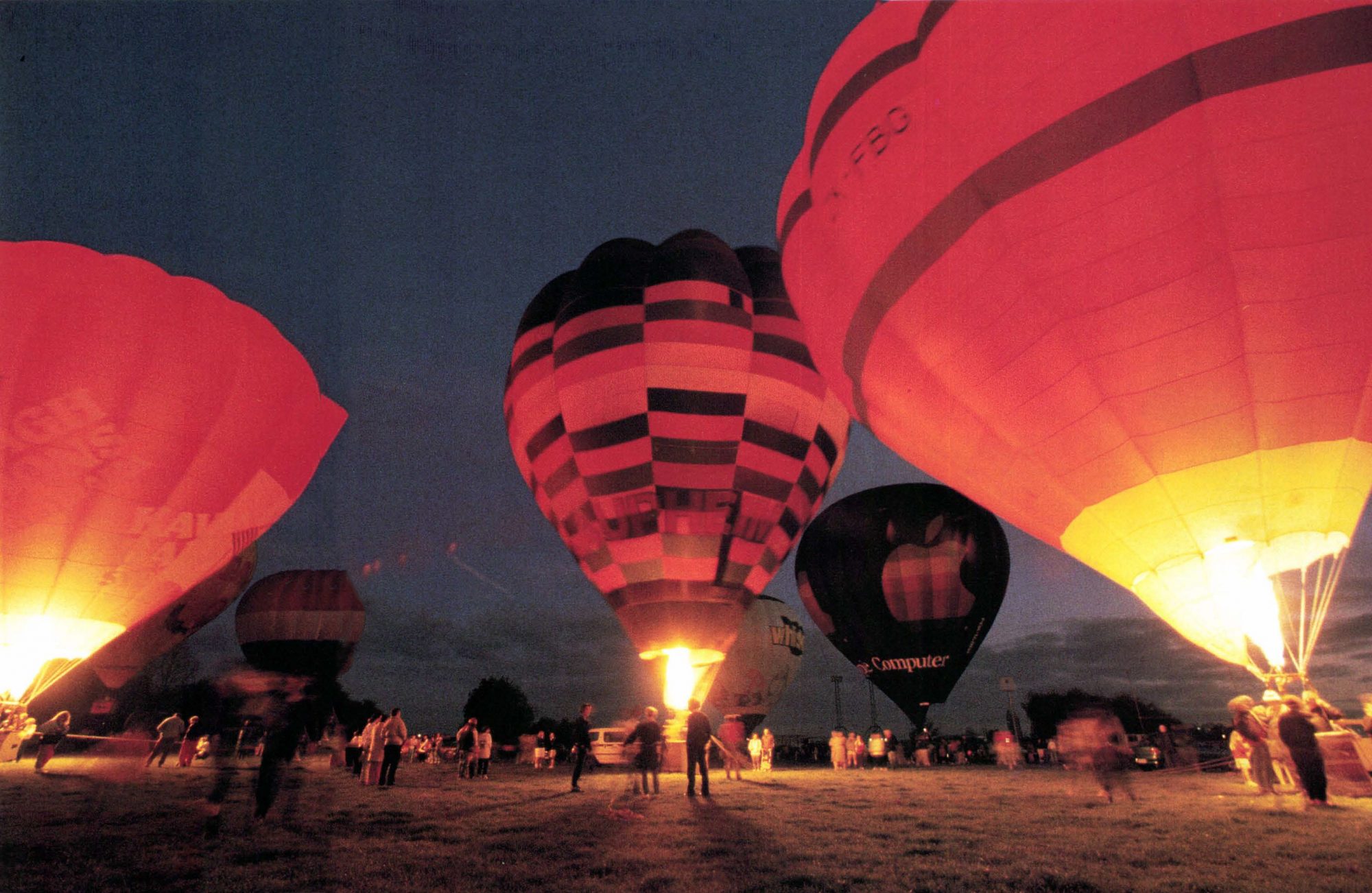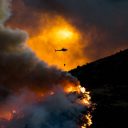
Sure to rise
It has been more than a century since the first hot-air balloon soared into New Zealand skies. In the early years, ballooning was largely entertainment, with daredevil exponents impressing the crowds by dangling from trapezes and leaping from their balloons with primitive parachutes. Today, it is both sport and sightseeing, as Wellington journalist Mark Coote discovered at the New Zealand Hot Air Balloon Fiesta, held at Hamilton in May 1991.
When “Professor” Thomas bBaldwin,former tightrope walker, addressed the crowd at the Caledonian Ground, Dunedin, on the evening of 21 January, 1889, few would have been prepared for what was to follow. The Professor, newly arrived from America, must have cut a dashing figure in his frock coat and top hat as he supervised the final preparations for flight. His yellow oiled-silk balloon had already been filled with coal gas and stood ready for ascent.
With aplomb, the aeronaut dons his parachute and seats himself on a bar underneath the balloon. He signals the rope handlers to release the balloon, and, to the astonishment of the gasping crowd, is whisked a thousand feet into the air. The next instant he seems to fall, plummeting downwards with arms raised high above his head and body perfectly rigid. The horrified onlookers breathe with relief when, at last, the parachute fills, and the Professor wafts safely back to earth. They have just witnessed what is probably New Zealand’s first balloon flight and para chute jump.
In 1991, balloonists prefer to remain within the safety of their wicker baskets, and fly more for pleasure than daring. The ballooning fraternity is small—there are only 18 balloons in the country, and only 15 of these in regular use—but growing, and sightseeing by balloon is becoming an increasingly popular way of spending a few hours and a few dollars.
The recent Hot Air Balloon Fiesta, held in Hamilton over the weekend of 11-13 May, was the second national gathering of balloon enthusiasts, and was the largest number of balloons ever assembled in one place in New Zealand. Fourteen balloons took part, including three from Australia.
Today’s balloons are made from polyester or nylon ripstop fabric similar to that used in yacht spinnaker sails. At normal operating temperatures (between 50 and 100°C at the crown, depending on the amount of lift required) the fabric has a life of about 400 hours. Unlike Professor Baldwin’s gas-filled balloon, all modern balloons use hot air, in this country generated by LPG-fuelled burners which hang just below the balloon envelope.
The largest balloons at the fiesta stood a full 28 metres tall (the height of an eight-storey office block) when fully inflated, and had a capacity of 105,000 cubic feet. At an ambient air temperature of 15°C these monsters can lift 833 kilograms and stay aloft for up to three hours.
All balloons in this country must have a certificate of airworthiness. They do not carry navigational equipment, and are treated in exactly the same way as other small aircraft, being restricted to visual flying. This means they are not permitted to fly in cloud or heavy fog.
As well as good visibility, balloons need stable air conditions in which to fly. In New Zealand, maximum wind speed for safe flying is around 10 knots, a figure determined more by the problems of landing than by any difficulties with high-wind flying. In the Waikato, for example, paddocks are small, and wind greater than 10 knots is unsafe—no one wants to be dragged into a barbed wire fence while trying to land.
Rain is out, too. Water on the envelope increases the weight of the balloon, thereby reducing its lifting capacity, and the fabric needs to be packed away dry to prevent mildew. “You can’t just throw a wet balloon over the clothes line when you get home!” says Aucklander Robin Campbell. More importantly, rain is an indication of unstable air.
Water is not entirely shunned by balloonists, though. One of the fiesta’s competition events, the “Splash ‘n’ Dash”, required balloonists to launch themselves from a point of their choice approximately 1500 metres from Hamilton’s Lake Rotoroa. If they judged the breeze correctly they would then fly to the lake, dip the bottom of the basket into the water and take off again, landing outside the 1500-metre mark. Only four balloons accomplished this feat.
I accompanied Stan Turner, from Palmerston North, and two other passengers on this flight. After much discussion and thoughtful deliberation over our launch site, we missed the lake by a country mile!
As if in consolation, we made a perfect landing. Stan judged precisely the amount of hot air to feed into the envelope so that we pulled up just as we made contact with the ground. At this point we “ripped out”, pulling furiously on the red cord to open velcro seams in the crown of the envelope. This allowed the hot air to escape, preventing the balloon from rising up again, or being dragged along the ground by any wind.
It is a myth that balloons are a quiet method of travel. To maintain altitude, the pilot must blast a huge blue flame of vaporised LPG into the envelope every 20 to 30 seconds. The burners create an incredible amount of noise and heat. I noticed that all the balloonists wore hats of varying description, and though such accoutrements are probably in line with the dashing nature of the sport, I suspect that they also protect the wearer from overheating.
Part of the skill of ballooning is knowing how much hot air to feed into the envelope, and when. It takes about 30 seconds after switching on the burner for the balloon to rise. Once, when lifting off from the showgrounds, we seemed to be heading straight for a stand of trees on the perimeter. The pilot wasn’t burning at the time, and didn’t appear too concerned. Moments later we started to rise, and cleared the trees by a few metres. We sailed low above the canopy, coming close enough to one tree for us to lean out of the basket and grab some leaves!
Balloons can be steered because of a fortuitous quirk of physics: air currents move in different directions at different heights. You simply rise or descend until you chance upon an air current moving in the direction that you want to travel.
The pilots’ ability to predict air movements was tested during a “Hare and Hounds” race at the fiesta. The Launch Master took off from the Claudelands Showgrounds 15 minutes before the rest of the pack, whose mission was to follow his lead and drop a marker as close as possible to the point where he landed. The 12 hounds were all trying various altitudes to match the hare’s path.
The most visual spectacle of the weekend was literally “turned on” for the public on Sunday night. The balloons were tethered to cars, then lit up from the inside by feeding liquid LPG into the burners, rather than the usual vaporised gas. The result was a huge orange flame which shot up inside the envelope, turning each balloon into a giant light bulb.
Another crowd-pleaser was Australian Kiff Saunders, who flies solo in a Cloud Hopper—a small, basketless balloon in which the pilot uses a parachute harness and a bench seat to support himself underneath the envelope. With an LPG tank strapped to his back and the burner just above his head, he made a bizarre sight as he floated around suburban Hamilton, occasionally dropping in on someone’s front lawn, to the delight of the children who were running up the street beneath him. At $12,000, the Cloud Hopper is a cheap option compared with a traditional balloon, which can cost anywhere between $40,000 and $70,000.
Kiff, who works for an Australian ballooning company, says that the sport “is a great way to look at the world. It gives you an understanding of the things that go on around you that you otherwise take for granted”. He must certainly have had a great view of the world when he once took his balloon up to 5500 feet. This would have been an Australian record for a basketless balloon had he gone through the proper channels.
By the end of the weekend I was a convert. The freedom you feel drifting high above the countryside is immense—quite different from being encapsulated in a plane or glider. You can see in any direction, and there is nothing between you and the world below except a wicker basket. When you lift off, and rise above the envious people waving below, you really do feel like you’re setting off on an adventure. You have no idea exactly where you will land, other than that it will be in the direction the wind is blowing.
Professor Baldwin, I salute you.













